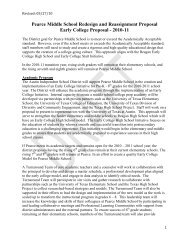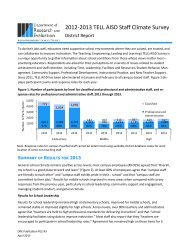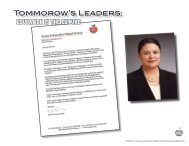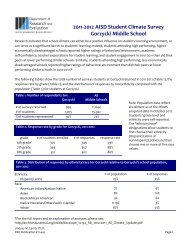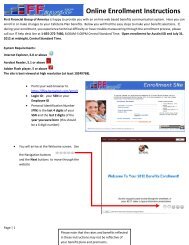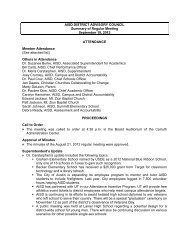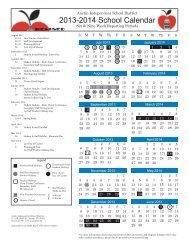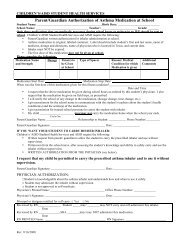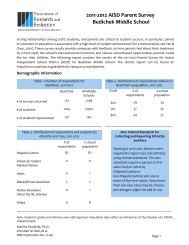Important information for ALL new classified employees - Austin ISD
Important information for ALL new classified employees - Austin ISD
Important information for ALL new classified employees - Austin ISD
You also want an ePaper? Increase the reach of your titles
YUMPU automatically turns print PDFs into web optimized ePapers that Google loves.
BLOODBORNE PATHOGEN SAFETY INFORMATION<br />
What are bloodborne pathogens?<br />
Bloodborne pathogens are disease causing germs that enter the body through exposure to blood or other<br />
bodily fluids.<br />
What diseases do they cause?<br />
Bloodborne pathogens primarily cause:<br />
• Hepatitis B –The liver is attacked by the virus. It is vaccine-preventable.<br />
• Hepatitis C –The liver is attacked by the virus. No vaccine is available.<br />
• Acquired Immune Deficiency Syndrome (AIDS) – The immune system is<br />
attacked by the Human Immunodeficiency Virus (HIV). There is no vaccine available.<br />
How are bloodborne pathogens spread?<br />
Bloodborne pathogens are primarily spread through contact with an infected person’s blood. Also, contact<br />
with other potentially infectious material (called OPIM), such as semen, vaginal secretions, other body<br />
fluids or tissue containing visible blood may spread disease. The most common means of transmission are<br />
needle sticks, unprotected sexual intercourse, and human bites.<br />
Who can transmit these diseases?<br />
As a school district employee you will probably not know if a staff member or student has a bloodborne<br />
disease since the germs can infect people from all walks of life and all ages. In addition, many infected<br />
people have no symptoms and often do not know that they are carrying any disease.<br />
How can you protect yourself from exposure to bloodborne pathogens?<br />
• Learn about the diseases and how they are spread.<br />
• Attend a Bloodborne Pathogen class conducted by your school nurse.<br />
• Use Standard Precautions and follow the exposure control plan <strong>for</strong> <strong>Austin</strong> Independent School<br />
District.<br />
• Use barriers to exposure to blood and body fluids such as condoms or gloves.<br />
• Do not share needles. Properly dispose of needles (sharps) in specified containers.<br />
• Avoid getting tattoos or body piercing unless the technicians follow all safety practices.<br />
• Do not share toothbrushes or razors.<br />
• Report any possible exposure immediately to your supervisor.<br />
• Get the Hepatitis B vaccine. *<br />
*While it is advisable that all persons receive the Hepatitis B vaccine, the A<strong>ISD</strong> provides the vaccine free<br />
of charge to those staff who are considered at “high risk” of exposure to bloodborne pathogens. The<br />
following job classifications with A<strong>ISD</strong> apply:<br />
• Nurse (to include nurse practitioners, registered nurses, licensed vocational nurses)<br />
• Health Assistant<br />
• Athletic Trainer<br />
• A<strong>ISD</strong> Police Officer/Security Guard/SRO<br />
• Special Education Staff (teachers and teacher assistants in PPCD, Life Skills and ED units)<br />
• Custodian<br />
• Auxiliary/Ancillary Staff (bus drivers and monitors)<br />
• Unlicensed Diabetes Care Assistant (UDCA)<br />
• A<strong>ISD</strong> Quick Care Staff<br />
• ALC Staff/Teacher Assistant<br />
The vaccine is very well tolerated and requires a series of three injections given at specific intervals <strong>for</strong><br />
maximum protection. If you are in a high risk category position, you have the option to consent (in<br />
writing) to receive this vaccine or decline it at this time. The vaccines are administered once per month<br />
during the school year. For more <strong>in<strong>for</strong>mation</strong> you may contact the A<strong>ISD</strong> Risk Management<br />
Department at 414-2294.<br />
S:\CPerShare\NEW HIRE FORMS\2010 New Hire Forms\Bloodborne Pathogen Form.doc 4/18/07


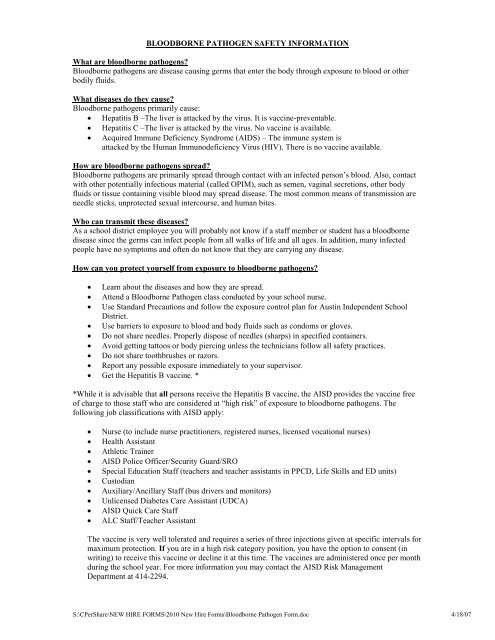
![Pageflex Server [document: PR1986512_00001] - Austin ISD](https://img.yumpu.com/27239252/1/190x245/pageflex-server-document-pr1986512-00001-austin-isd.jpg?quality=85)
